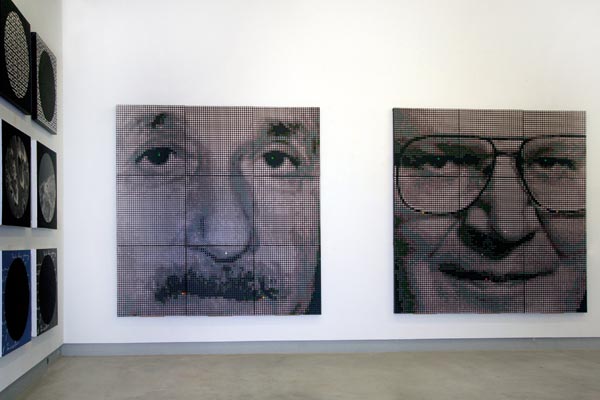
In “The Epilogue”, paintings of both the dot and the line are rendered with methodical steps used to experiment with the optical and perceptual effects of motion on canvas, including painting on a moving canvas. The act of painting inherently requires movement of the paint. A myriad of perceptual effects occur when the canvas spins clockwise and the paint is applied counterclockwise; or when the paint is applied and sandwiched between two canvases set in motion; or when painted color fields are masked with a mechanically-cut vinyl stencil of a large dot, a 121 dot grid, or a complex line-drawing. The line, the dot and the distinctive and unique fractionated and optically mixed color effects become the perception of the viewer, the measuring instrument of the experiment.
Einstein, Mandelbrot, and their Foortprints on the Sands of Time…Go Digital!, 2010, installation at studio601, New York, NY
Conceptually, the show focuses on relative motion, parallax, intuitive reasoning and the new geometry of irregular forms and surfaces by which both Albert Einstein and Benoit Mandelbrot have added an expansive dimension to our temporal and spatial understanding of the universe, let alone its art! Kolker’s high definition fractionated images of transformed NASA images of Neil Armstrong’s, Buzz Aldrin’s and Mike Collins’ footprints on the moon in July 1969 are attributed to computer programs based on the fractal geometry of Mandelbrot. Einstein’s relativity and field theories were instrumental to missions to the moon and now, to much farther places. The motion painting experiments reference Einstein’s ‘spinning buckets of water’ and ‘stone dropping from the train’ in his “Special Theory of Relativity” and the outcomes of the paintings are the expansive curvilinear non-Euclidean geometric shapes of Mandelbrot. The fractal boxes of mirror and lights iterating ad infinitum within their depths also reflect the images of the surrounding paintings. Depending on the position of the viewer standing relative to these light sculptures, the parallactic reflections of the exhibition space, along with the sculpture’s internal light patterns, give the illusion of motion within the sculpture. Large scale portraits of Einstein and Mandelbrot, painted in Kolker’s signature dichromic tints and shades are highlighted in vivid primary colored solitary dots. When a highlighted area is fixated upon for several seconds and another highlighted area is gazed upon, the viewer’s focus autonomically shifts repetitively from one site of the portrait to another, creating the illusion of motion through after-images in what is otherwise a static portrait.
In a panoply of color, fractionation and motion, “The Epilogue” concludes the Go Digital! yearlong series by questioning our ways of ‘seeing’ with both the cognitive tools of analogy and of deductive reasoning and the sensory tools for human perception as a means of exploring our world gone digitally wild beyond empiricism. Through his homage to Einstein and Mandelbrot, Kolker reasserts the importance of intuition and genius in order to provide us with avant garde theories. What are today intuitive and perceptual, may tomorrow be the so-called evidence based truths of the world of arts, sciences and the law.
Paul Kolker: “Einstein, Mandelbrot, and their Footprints on the Sands of Time… Go Digital! The Epilogue” — February 25 through April 16, 2010.




